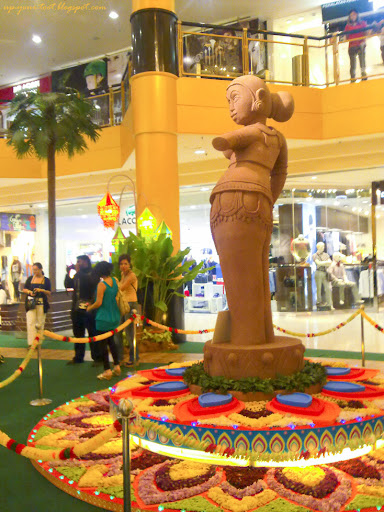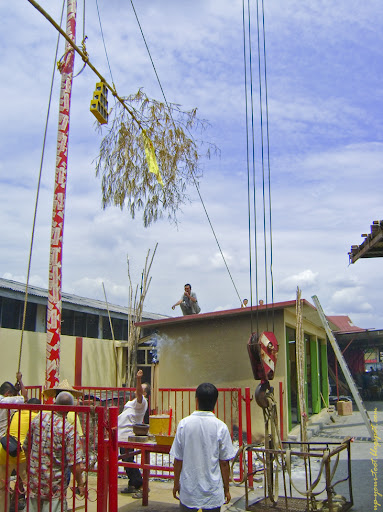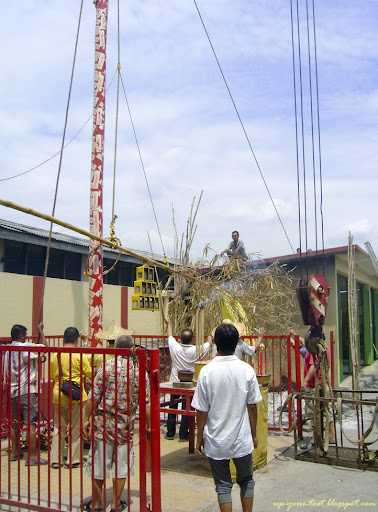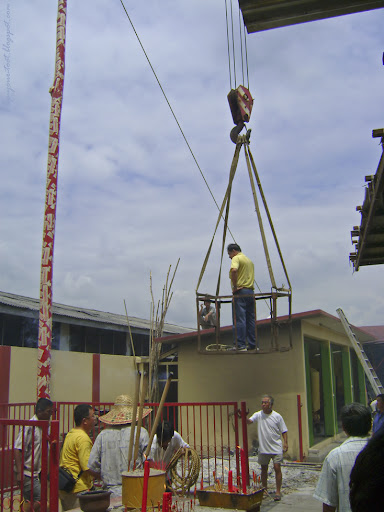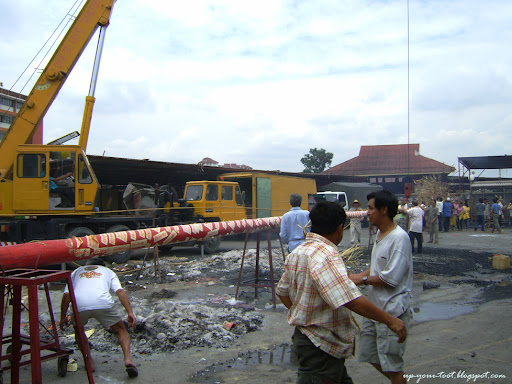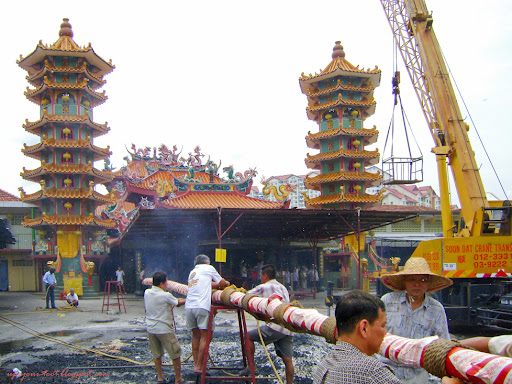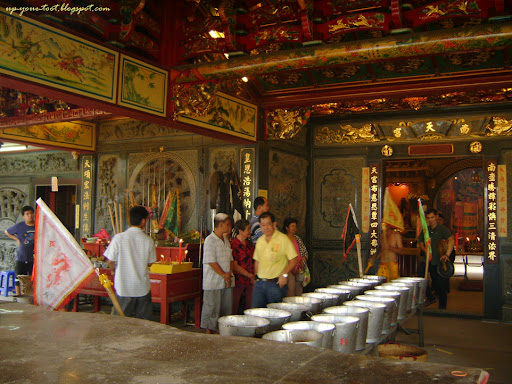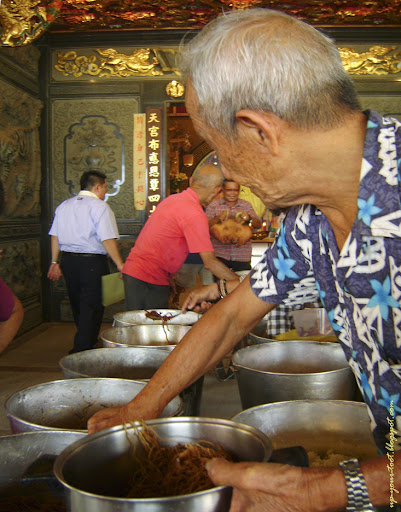Since the last post has been about a temple (Nan Tian Gong) at one end of Jalan Ampang, and today is one of the three celebration days for Guan Yin (Avalokitesvara / Guan Shi Yin / Guanyin Pusa [觀音菩薩 / 观音菩萨] / Gwan-eum [관음] / Quan Âm / Kannon / Kwan Im), I have decided to post about another temple on the other end of Jalan Ampang, i.e. the KLCC end of Jalan Ampang. Guan Yin is a popular deity, that is the reason why she/he has name variants in so many languages (
my post on one of the temples dedicated to her in Penang).
A little temple at the KLCC end of Jalan Ampang that usually goes unnoticed by many people who come to this part of town. This temple is better known as Kun Yam Thong (literally Guan Yin's Hall) in Cantonese, but the name on the signboard says Deng Bi An (登彼岸) which means stepping to the other shore. True enough, stepping into the temple grounds makes you feel like you have been transported away from the hustle and bustle of KLCC and the city roads into a tranquil garden of peace and serenity; unless you happen to go on the first or the fifteen of the lunar month or any of the deities celebrations days - where the atmosphere is more festive.
 |
The Thousand Arm Thousand Eye Avalokitesvara at the temple. In front of the large image is the Zhunti Bodhisattva (also Zhunti Guan Yin Bodhisattva when considered as an emanation of Avalokitesvara). Guan Yin appears to be wearing a green jade-like necklace. This is actually a representation of the attainment of perfection of Wisdom (prajna/panna paramitta).
|
The upper signboard on the arch reads (法界觀音聖寺 / 法界观音圣寺), and when loosely translated means Dharma Realm Guan Yin Supreme Being Monastry/Temple i.e. the temple/monastry of the Supreme Being Guan Yin in the Dharma Realm - in other words, the noble Guan Yin's place. This place is more well known over the internet as Dharma Realm Guan Yin Sagely Monastery (if you ask me, the word sagely is a horrible, out of context translation).
 |
| The entrance to the temple. Note the tall buildings that flank the temple. |
How to get there?
It is located just beside Menara Atlan (formerly Menara Naluri) / the Zon on the Jalan Ampang side (you can walk through the Zon to Menara Atlan from the KLCC Park side). Restorant Chef Choi flanks the temple's other side and somewhat opposite the temple is Corus Hotel. If you exit from Isetan in Suria KLCC at the ground floor (the Menara Maxis side exit), walk towards Jalan Ampang. At the junction (facing Jalan Ampang), just turn right (heading in the direction of the Jalan Tun Razak intersection) and walk down the road past Wisma Central and continue past Pelita Nasi Kandar and Restaurant Chef Choi. You will catch sight of the temple (or at least the temple's perimeter) once you pass by Pelita Nasi Kandar.
A Brief Historical Account of the Temple
The premise was previously a syncretic Chinese temple (i.e. a mixture of folk Taoism and Chinese Buddhism) and is supposedly to have been founded in 1880. The Dharma Realm Buddhist Association (a group founded by the late Venerable Master Hsuan Hua in 1959) moved into the temple in 1993, making it one of their branch centres.
So there's nothing left of the old temple?
Well, not quite, apparently. Despite the rebuilding of the entire temple, it is based on the old structure. Plus the main deity of the old temple, which is Cundi Bodhisattva (Zhunti Pusa 準提菩薩/准提菩萨) is still venerated on the Guan Yin altar (in front of the Thousand Armed Guan Yin). She is, like Guan Yin, known with many different names, but her iconographic representation is unmistakably specific. Also, the two Dharma guardians that stands flanking the Buddha's altar used to stand beside Cundi Bodhisattva (Zhunti Pusa).
Wait, we were talking about Guan Yin, now who is Cundi?
As Guan Yin's manifestation, Cundi represents her bala viriya - positive strength and energy that goes all out to help others. However, Cundi also existed as a deity on her own before records of her being the manisfestation of Guan Yin appeared. Sometime venerated as Fo Mu Zhunti Pusa (佛母准提菩萨 / Zhunti the Mother of the Buddha), she can be found standing in many syncretic temples. Her representation bears an uncanny resemblance to a Daoist deity, Dou Mu (斗母) the Mother Creator. Dou Mu's position parallels the Indian accounts of the Chandi, a manisfestation of Durga/Shakti (the ultimate female deity). Chandi is of course a 'fierce' deity, in the same league as Kali.
An interesting fact is that the full mantra for the Chinese Zhunti has similarities with the Hindu mantra for Chandi; namely it contains what appears to be syllabic equivalents to the Indian version of Aim, Hreem and in some esoteric recitation, the Kleem being placed at the end of the mantra proper. Furthermore, Durga rules the world with her power of Maya, i.e. illusion. It so happens that the Buddha's mother is also called Lady Maya. And in Mahayana and Tantra schools, she is the mother of seven billion Buddhas - Sapta koti Buddha maitri Cunda devi. Hmm, confused?? Well just let it be...
Her Chinese iconographic representation appears peaceful, but do not let her smiling face trick you. Chinese (unlike Indian craftsman) do not overtly represent fierce female deities (well, they do, but only for those that are esoteric in Nature) with tongue hanging out and knives that are dripping with blood. The only identifying feature that Zhunti is a 'fierce' female deity is her hair - dishevelled hair. Peaceful forms of deities have tied up or hair that is kept hidden by a shawl. If you see dishevelled hair in female Chinese deities - think of female power in the likes of Kali.
 |
Zhunti Pusa in front of the Thousand Armed Guan Yin. Zhunti has eighteen arms and her 'weapons' are different in arrangement from the standard Guan Yin. Notice that Zhunti has dishevelled hair coursing down her shoulders.
|
The Temple Layout
If the discussion about Guan Yin and Zhunti sets your head spinning in circles, it is then time to go round (or rounds - you can circle the temple in as many rounds as you like) and take a look at the temple. Immediately passing through the gates, you come face to face with the Chinese representation of Maitreya Buddha, pot bellied and laughing joyously sitting in the central entrance of the temple (this is the first altar that you come across). Here you can give a small donation and get three joss sticks to light up and offer to the deities. There is minimal use of joss sicks here, unlike in syncretic temples where more smoke equals better. On both sides of Maitreya is the Four Heavenly / Directional Kings (Cāturmahārājika / 四大天王) who are the guadians of the four directions of the Earth.
 |
As it was a festival day, the altar in front of Maitreya is filled with candles and fruits and underneath the altar table, bags of rice. The offerings are brought in for Guan Yin, but as the altar on the inside has limited space for candles (safety reasons) and foodstuff, they are placed here in front of Maitreya.
|
 |
| Two of the Four Heavenly Kings - Dhṛtarāṣṭra (East - pipa) and Virūḍhaka (South - sword). |
Walking past the four heavenly kings, and directly behind Maitreya is Wei Tuo Bodhisattva, the guardian of the Dharma objects in a temple. Also known as Viharapala (guardian of the vihara - temple) or Sri Skanda, his image in a Buddhist temple always faces inwards; for he is said to get angry easily when confronted with the wrongdoings of worldlings and to prevent him from raising his weapon and striking someone, legend has it that the Buddha asked him to only look inside the vihara. I think this temple has a large number of Viharapala statues for a temple its size (three altogether), so much so that I sometimes tell my friends its the Viharapala Temple of KLCC. Perhaps the temple does require that many eyes to keep watch over it as it is located in a materialistic, hedonistic and indulgent area of town.
 |
| Peeking through Dhṛtarāṣṭra's guard. |
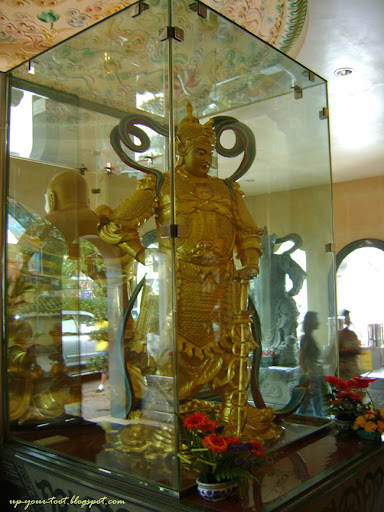 |
A grand and handsome looking Viharapala keeping watch on the temple. He faces the Thousand Armed Thousand Eyed Guan Yin altar.
|
Facing the first Viharapala (and the largest) is the next altar (the central altar) dedicated to the Thousand Armed Thousand Eyed Guan Yin (Sahasra-bhuja Sahasra-netra Aryaavalokitesvara Bodhisattva) and Zhunti Pusa. There are a few cushions here where you can kneel down and say your prayers. Behind the Thousand Armed Guan Yin, stands another, well, Viharapala, this time looking at the three Buddhas in the main hall.
On the back of the halo and arms of the Guan Yin, are inscribed with three mantras. The first one in the middle is Om Ah Hum!. The next one on the lower section (behind Viharapala) is the famous six syllable mantra Om Mani Padme Hum! The third mantra (actually a dharani) covers the rest of the available space - the Great Compassion Mantra (大悲咒).
 |
Viharapala (again) standing guard behind Guan Yin. The mantra Om Ah Hum! and Om Mani Padme Hum! can be seen together with the Great Compassion Mantra on the back of Guan Yin's halo and 'hands'.
|
Beyond the Guan Yin altar is a larger space that serves as the prayer hall. This main altar (the third and innermost) which houses the three Buddhas has a pair of guardian bodhisattvas - Qie Lan (Sangharama which is the Chinese deity Guan Di) and Wei Tuo (Viharapala - associated with Muruga/Skanda, an Indian deity). This pair of guardian deities are supposedly already in existence from the time of the original temple and used to stand guard for Cundi Bodhisattva.
Each of the Buddha on the main altar weighs a tonne. So that is three tonnes of Buddhahood for you (maybe that is why the temple needs three Viharapalas to stand guard - the burden is just too heavy to be born by a single guardian deity). Mounted high on the walls of the main hall by the side of Guan Yin altar are the 18 Arahants (nine on each side), the statues gilded with gold.
 |
The view from the main prayer hall looking out onto Guan Yin's back. Up on the far right wall is the gold gilded statues of nine of the the 18 Arahants of Mahayana Buddhism. The other nine Arahants are on the left wall. Rows of cushions are placed for the Dharma assembly so that they can kneel in comfort.
|
 |
He ain't heavy, he is the Buddha - The three Buddhas at the main altar (from left to right): Amitabha Buddha, Sakyamuni (Gotama) Buddha and Baishajya Guru Buddha. In the foreground you can see Viharapala (Sri Skanda) Bodhisatva as one of the Dharma Guardians. The Buddha each weighs a tonne!!
|
If you stand looking out of the temple, there is a small room on your left that houses a statue of the late Ven. Hsuan Hua, founder of the Dharma Realm Buddhist Association. His statue has a life-like uncanniness and can be a bit unnerving to look at, as if the late Ven. Hsuan Hua is alive and sitting there with gold painted skin and would suddenly lean forward and whisper something in your ear like one of those people that pretend to be statues. If he ever does that, I would be the first to run out from the temple screaming!
 |
| Statue of the late Ven Master Hsuan Hua. |
Besides the main hallway, the temple has two side halls (on both sides of the temple). Looking on into the temple, the hall on the right side of the building is dedicated to Baishajya Guru Buddha (the Medicine Guru Buddha) whilst the one on the left is dedicated to Ksitigarbha Bodhisattva (Earth Store Bodhisattva). On the altar of Ksitigarbha Bodhisattvas, there are also some ancestral tablets and tablets of deities.
 |
| The Medicine Guru Buddha. |
 |
| The Earth Store (Ksitigarbha) Bodhisattva. |
Vegetarian Food
The temple has a very popular vegetarian food canteen at the rear portion of the compound that is open during lunch time. A large number of their clientele are executives and big bosses from the surrounding offices. The canteen also provides free vegetarian food on the first and the fifteen of the lunar calendar. They focus on serving healthy natural vegetarian food and do not use MSG.
 |
| From the inside of the temple archway, one can see tall buildings and the bust road outside. Incribed on the archway - Bodhi. Perhaps the peace and tranquility is a representation of enlightenment, a small moment of bliss in this chaotic world. |
Conclusion
All in all, this temple is the antipodal of what this part of town represents; peace versus the hectic bustling lifestyle, calm verses the honks of cars and buses, healthy vegetarian food versus MSG laden processed food. It certainly lived up to its name, Stepping on the Other Shore.


